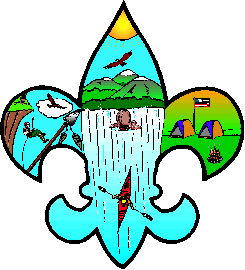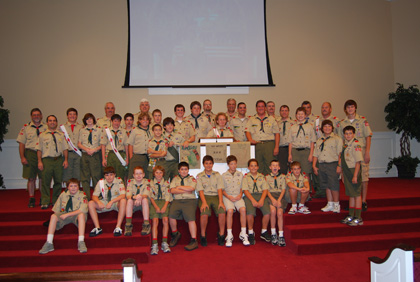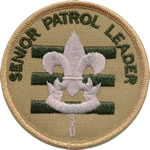

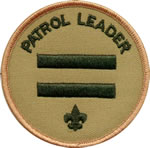
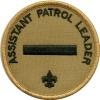
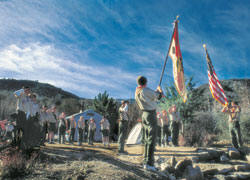
The members of each patrol elect one of their own to serve as Patrol Leader. The troop determines the requirements for patrol leaders, such as rank and age. To give more youths the opportunity to lead, most troops elect patrol leaders twice a year. Some may have elections more often.
Patrol size depends upon a troop's enrollment and the needs of its members, though an ideal patrol size is eight Scouts. Patrols with fewer than eight Scouts should try to recruit new members to get their patrol size up to the ideal number
|
|||
| William "Green Bar Bill" Hillcourt |
The Patrol Method
|
|||
| Robert Baden-Powell |
The Patrol Method gives Boy Scouts an
experience in group living and participating
citizenship. It places responsibility on young shoulders
and teaches boys how to accept it. The patrol method
allows Scouts to interact in small groups where members
can easily relate to each other. These small groups
determine 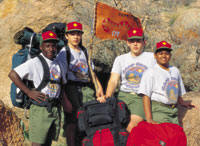 troop
activities through elected representatives.
troop
activities through elected representatives.
|
|||
| Robert Baden-Powell, Aids to Scoutmastership, 1919, page 49 |
|
|||
| Robert Baden-Powell, Aids to Scoutmastership, 1919, page 24 |
|
|||
| Robert Baden-Powell, Aids to Scoutmastership, 1919, page 24, 32 |
|
|||
| Robert Baden-Powell, from Are Our Boys Degenerating?, ca. 1918 |

Types of Patrols
Some troops may have different "kinds" of patrols, all of which should function using the Patrol Method. The use of these different types of patrols is optional and should be determined by the youth members of the troop and the Patrol Leaders' Council.
New-Scout patrols are for 11-year-old Scouts who have recently joined the troop and are together for the first year in the troop. An older, experienced Scout often is assigned as a Troop Guide to help the new-Scout patrol through the challenges of troop membership. An assistant Scoutmaster should also assist the new-Scout patrol to ensure that each Scout has every opportunity to succeed right from the start. The new Scout patrol is sometimes formed from a Webelos Den after bridging into Boy Scouts.
"Regular" patrols are made up of Scouts who have completed their First Class requirements. They have been around Scouting long enough to be comfortable with the patrol and troop operation and are well-versed in camping, cooking, and Scouting's other basic skills.
A Venture patrol is an optional patrol within the troop made up of Scouts age 13 and older. These troop members have the maturity and experience to take part in more challenging high-adventure outings. The Venture patrol elects a Venture Patrol Leader, who works with the Assistant Scoutmaster - Venture to put the patrol's plans into action.
Patrol Meetings
Patrol meetings may be held at any time and place.
Many troops set aside a portion of troop meetings for
patrol meetings. Others encourage patrols to meet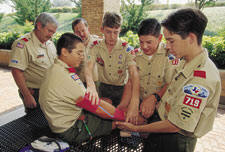 on a different evening at the home of a patrol member.
The frequency of patrol meetings is determined by
upcoming events and activities that require planning and
discussion.
on a different evening at the home of a patrol member.
The frequency of patrol meetings is determined by
upcoming events and activities that require planning and
discussion.
Patrol meetings should be well-planned and businesslike. Typically, the patrol leader calls the meeting to order, the patrol scribe collects dues, and the assistant patrol leader reports on advancement. The patrol leader should report any information from the latest patrol leaders' council meeting. The bulk of the meeting should be devoted to planning upcoming activities, with specific assignments made to each patrol member.
Patrol Activities
Most patrol activities take place within the framework of the troop. However, patrols may also conduct day hikes and service projects independent of the troop, as long as they follow two rules:
- The Scoutmaster approves the activity.
- The patrol activity does not interfere with any troop function.
Patrol Spirit
Patrol spirit is the glue that holds the patrol together and keeps it going. Building patrol spirit takes time, because it is shaped by a patrol's experiencesgood and bad. Often misadventures such as enduring a thunderstorm or getting lost in the woods will contribute much in pulling a patrol together. Many other elements also will help build patrol spirit. Creating a patrol identity and traditions will help build each patrol member's sense of belonging.
Every patrol needs a good name. Usually, the patrol chooses its name from nature, a plant or animal, or something that makes the patrol unique. A patrol might choose an object for its outstanding quality. For example, sharks are strong swimmers and buffaloes love to roam. The patrol may want to add an adjective to spice up the patrol name, such as the Soaring Hawks or the Rambunctious Raccoons.
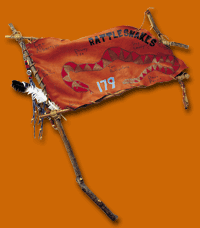 A
patrol flag is the patrol's trademark. In addition to
the patrol name, the patrol flag should have the troop
number on it as well as the names of all the patrol
members. Mount the flag on a pole, which also can be
decorated. Remember, the patrol flag should go wherever
the patrol goes. The patrols emblem may be a
standard patch offered by the Boy Scouts or design
their own. The patrol emblem is worn on the right
sleeve.
A
patrol flag is the patrol's trademark. In addition to
the patrol name, the patrol flag should have the troop
number on it as well as the names of all the patrol
members. Mount the flag on a pole, which also can be
decorated. Remember, the patrol flag should go wherever
the patrol goes. The patrols emblem may be a
standard patch offered by the Boy Scouts or design
their own. The patrol emblem is worn on the right
sleeve.
Every patrol has a patrol yell, which should be short and snappy. Choose words that fit the patrol's goals. Use the yell to announce to other patrols that your patrol is ready to eat or has won a patrol competition. Some patrols also have a patrol song.
Patrols can earn the National Honor Patrol Award by completing specific requirements over a three month period, including having their own meetings, outings, and service projects.
